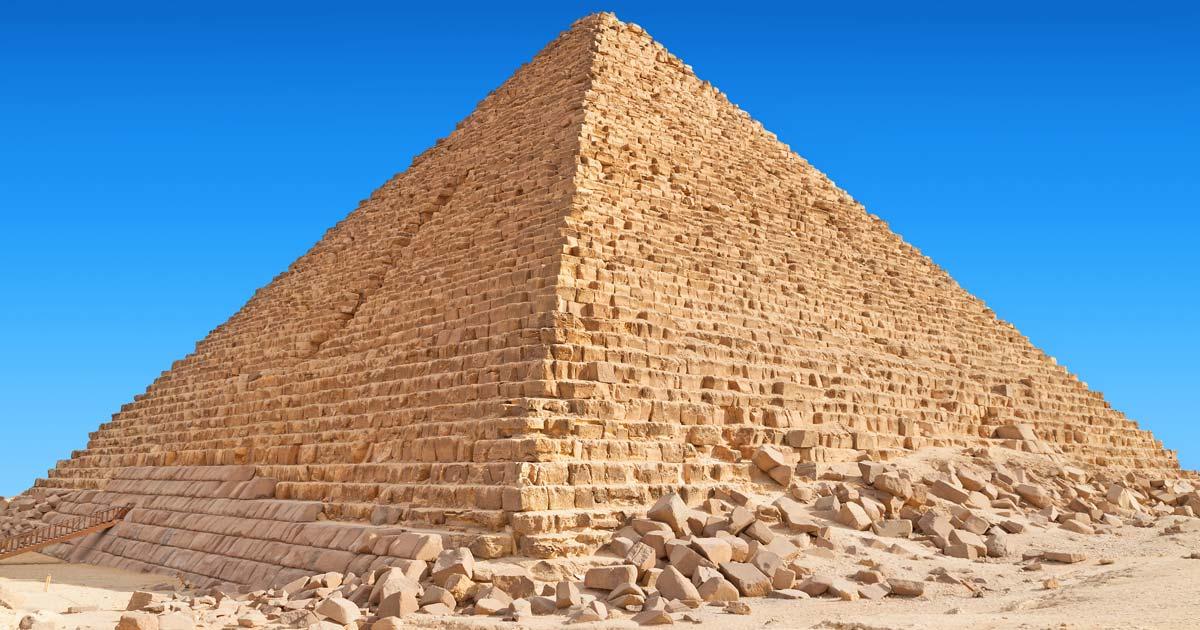
Has the Function of the Great Pyramid of Giza Finally Come to Light?
About 150 years after the establishment of Egyptology as an academic field, there still appears to be no agreement between scholars on the function of the Great Pyramid of Giza. Yet several different hypotheses have been proposed. The tomb hypothesis appeared when research began on the pyramid, with a popular belief saying the primary function of the pyramid was to be the final resting place for the second ruler of the 4th dynasty - Khufu.
Other competing theories were proposed as well: the granary, the power house, heaven’s mirror, water pump, and the Orion belt, among others. Reviewing all the main hypotheses with an open mind I came to conclusion that I cannot agree with any of those, so I propose my own. Certain aspects of the hypothesis were already voiced by others but not substantiated enough. I tried to fill the gaps where needed with additional facts and evidence.
It is well known that the Great Pyramid is located at the maximum geographical center of Earth (or close to it). No proposed hypothesis tends to explain why - most tend to ignore this fact or downplay it. If the pyramid is indeed built as a tomb, how did Khufu end up picking the location for the tomb to be at, or close to, the geographical center of Earth? With the pyramid construction estimated at 20 years, is mapping and charting the planet factored into the pyramid construction time?
How long did it take Khufu to survey the planet to determine that location? Similarly, how did the granary or power house end up at the center of Earth and for what reason? All the proposed hypotheses lack an explanation for this important aspect, and beyond any doubt it is critical in understanding the function of the Great Pyramid of Giza.
- Once Hidden in Plain Sight and Surprisingly Ignored: The Great Pyramid of Cholula
- 5 Pyramids of the Ancient World that You May Not Have Heard About
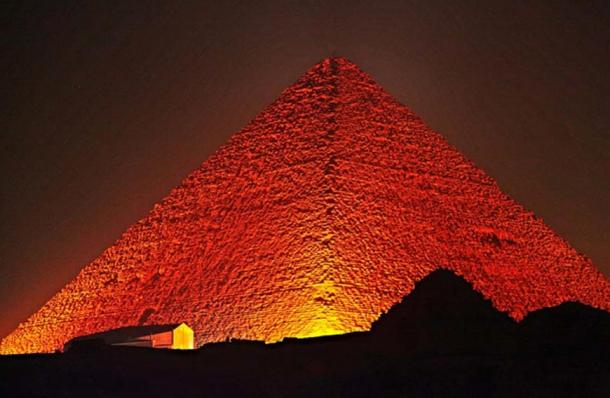
The Great Pyramid of Giza at night. (CC BY ND 2.0)
The Pyramid as a Source of Light
Light can be created by any system if it can emit charged particles into the ionosphere. The Aurora Borealis is the phenomena caused by the same process in which where electrons created by the sun collide with air molecules to create light. So, what would it take for the Great Pyramid of Giza to create similar light?
First, let’s talk about the construction material used in the Great Pyramid of Giza. If in the ancient past someone decided to build a system to emit electrons and create light, the person would definitely face a dilemma with the choice of construction materials. To accomplish that goal, high conductivity material at high frequency is needed. Copper has excellent conductivity and we know Ancient Egyptians had it in their toolbox, though at high frequency copper would overheat and melt within a few seconds. What other materials could be used?
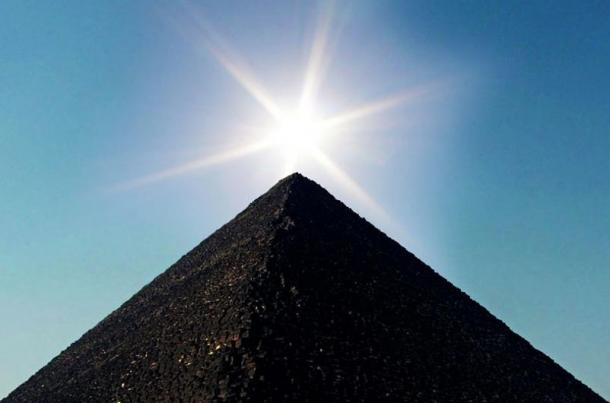
Great Pyramid of Giza in the rays of the sun. ( CC BY SA 3.0 )
Nummulitic limestone from the Abu Rawash area was analyzed by the National Research Center of Cairo. It was found its conductance improves at higher frequency - to the point where it is exceptional. If the conductivity of a material needs to be about 600 Tera Hz, in addition to structurally strong, there could not be better material than limestone.
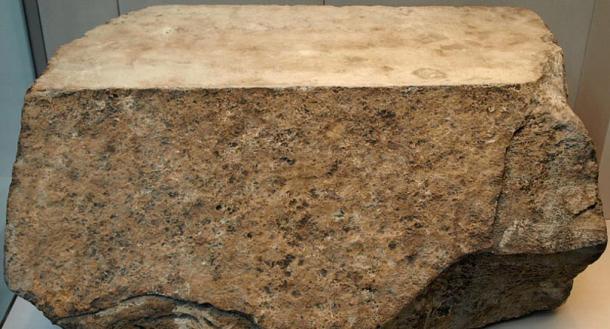
One of the original casing stones for the Great Pyramid (circa 2570 BC), most of which were removed during medieval times. This block was found in the rubble surrounding the pyramid. (CC BY SA 3.0)
The Great Pyramid is located at the geographical center of Earth, as noticed by Charles Smyth and reported in this book “Our Inheritance in the Great Pyramid” in 1864. The fact that the geographical center of Earth is at the location of the Great Pyramid is startling.
Now, for a structure to emit high frequency radiation (which is really light), it must be surrounded by a large land mass. This is the fundamental requirement for systems emitting electromagnetic radiation, of which any antenna design engineer is aware. If the pyramid needs to emit electromagnetic radiation on a scale of the whole planet, the maximum land mass location is ideal!

Antennas of the Atacama Large Millimeter/submillimeter Array (ALMA), on the Chajnantor Plateau in the Chilean Andes. The Large and Small Magellanic Clouds, two companion galaxies to our own Milky Way galaxy, can be seen as bright smudges in the night sky, in the centre of the photograph. (ESO/C. Malin/CC BY 4.0)
The electrons emitted by the pyramid need to reach the ionosphere and there is about a 100-km air gap between the peak of the pyramid and the ionosphere. The earth is a spherical capacitor, which means electrons at high frequency would propagate through the air with little impedance. Also, the ionosphere has negligible impedance, which means electrons can travel along the layer of the ionosphere to the other side of the planet with practically no restriction. However, they need to come back to the base of the pyramid to complete the closed path.
Passing through the ionosphere, the electrons would be colliding with atoms of various gasses, creating air glow similar to Aurora Borealis. The electrons travel back toward Earth from the ionosphere through elevation points of the planet.
It is interesting to note that many ancient cultures across the planet have had pyramid like structures. With the ionosphere saturated with charged particles, building a pyramid would provide a path for electrons to come back to the Earth’s surface - creating intense light glow over the structure. Reaching the surface, the electrons would return to the pyramid base through the mantle of the planet, the impedance of which is also negligible.
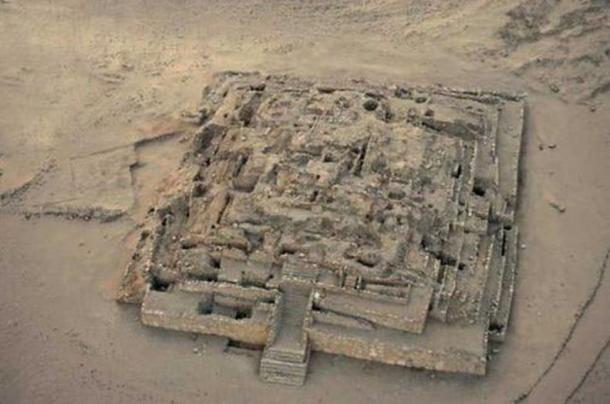
Remains of the Great Pyramid of Caral. (Christopher Kleihege / UNESCO )
As the electrons approach the Giza plateau, they would pass through caves filled with water. The finding of the caves was reported by Andrew Collins and Dr. Hawass. Another process took place there known as electrolysis, causing water molecules to split into hydrogen and oxygen gas. The gas mixture filling the caves caused air pressure build up on the bed rock, creating earth trembling and noise. It is interesting to note that the Pyramid Text has multiple references to quakes and trembles.
The Function of the Great Pyramid of Giza
The Great Pyramid of Giza has a few chambers, shafts, and passages. Each of the elements played an important role in producing light. I provide a description of the functions of the main components in the system below.

Great Pyramid of Giza plan. (Author provided)
Subterranean Chamber
The function of the subterranean chamber was to split water molecules into oxygen and hydrogen gas. For that you need to have water, terminals, and voltage. Hydrogen would accumulate around one voltage terminal (cathode) and oxygen would be around the other terminal (anode), but only hydrogen is needed for light, so oxygen needs to be rejected from the system. The front view of the subterranean chamber shows two hills made of limestone - those are two necessary terminals.
- Star Shaft Pointing - Busted: Debunking the Star Shaft Theory of the Great Pyramid
- The Hidden Message in Khafre’s Pyramid: What Were the Builders Trying to Tell Us?

Front view of the subterranean chamber. (Author provided)
The top view of the chamber shows some similarities between the terminals: the two terminal bases are about the same size and the division between the two plateaus is exactly centered. All this points to intelligent design of the subterranean chamber. You can also notice some differences which are intentional.

Top view of the subterranean chamber. (Author provided)
Note that the terminal on the left has a wider area compared to the terminal on the right. This means more electrons would pass through the terminal on the left side than right terminal. This would cause a voltage potential in which negative is on the right side, with the hydrogen gas accumulating there, and oxygen is on the left. Also, you can notice that the left and right shafts exiting the subterranean chamber are not leveled.
Hydrogen gas being lighter than the air, it would exit to the right and pass toward the ascending passage. Oxygen gas is heavier than air and would tend to concentrate at the bottom of the chamber. The granite block on the floor at the right shaft would prevent oxygen passing through. Some mixture would pass along, but it would not cause combustion. The gas built in the caves came out from the floor pit. This was not a steady process of gas and water slowly pouring out; it was a process of gas and water blasting out of the pit with high pressure.
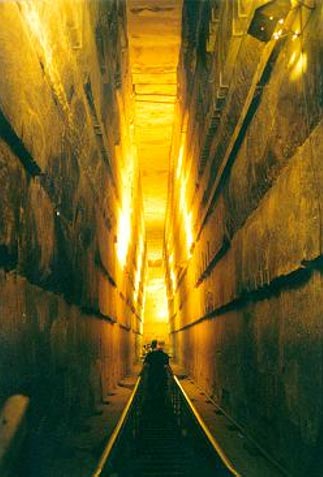
The Grand Gallery of the Great Pyramid. (Pprevos/CC BY SA 3.0)
The Queen’s Chamber
For the pyramid to create light, free electrons are needed, and hydrogen was used for that. To get electrons from hydrogen it can be pressurized, subjected to high voltage, or hit with EM radiation. All three processes were used in the pyramid. As the air pressure in the subterranean chamber increased, the hydrogen gas got pressurized in the Queen’s chamber - filling the southern and northern shafts. The shafts are blocked by Gantenbrinks doors, so it stayed there.
With pressure mounting, the temperature of the gas increased, and partial release of electrons took place. There are copper terminals in the doors to channel the EM radiation of stars into the system. Those align with the shafts. The alignment does not need to be perfect, just enough for X and gamma rays (which can pass through the blockage) to reach the copper. Then the ionization of hydrogen took place.

Gantenbrink’s Door. ( Image Source )
The King’s Chamber
The purpose of the King’s chamber was to collect all free electrons produced in the Queen’s chamber and push those toward the top of the pyramid. The granite beams in the King’s chamber are made of red granite, which has high crystal content when exposed to vibration and creates an electric field, pulling electrons from the Queens’ chamber toward the peak of the pyramid.

Opening to the King’s Chamber shaft. Morton Edgar, 1910. ( Public Domain )
Antechamber and Portcullis
The function of the portcullis in the antechamber was to control the hydrogen gas flow toward the King’s chamber and control pressure in the pyramid. Essentially, closing those would prevent the gas flowing out of the pyramid through the King’s chamber shafts. Controlling how much the portcullis closed, someone would also control pressure in the Queen’s chamber and how much light the pyramid would produce.
A Coffer in the King’s Chamber
The coffer in the King’s chamber is an important feature. What it was used for and why was it placed there are questions that still puzzle many scholars. The purpose of the coffer was to create high voltage in the King’s chamber to ionize the hydrogen and make that space conductive. Without a high voltage source in the chamber, the pyramid would not work. A device similar to the Baghdad battery could have been used. Or a device similar in construction to the Ark of the Covenant would also work.
- The Great Pyramid of Giza: A Modern View on Ancient Knowledge, Earth and Water – Part I
- Hidden Chamber Found? Cosmic Ray Tech Reveals Large Void in Great Pyramid

Sarcophagus in the King's chamber. (Brooklyn Museum)
Ascending Passage Plugs
There are three granite plugs in the bottom portion of the ascending passage. It appears the prevalent number of discussions support the theory that those were slid down to block the entrance to the ascending passage and were held there with wooden beams. There is, however, no agreement on the function of those plugs.
I believe those were used to shut down the pyramid at any instant if needed. It worked as an emergency stop. The three granite slabs would be slid down the descending passage to block hydrogen passing through and shut down the process. The fact that those plugs are blocking the passage now means they were used at least once.
Thus, I propose the function of the Great Pyramid of Giza was to emit free electrons to the Ionosphere, with the purpose to create light on the planet. The hydrogen gas produced in the subterranean chamber was used as a source of electrons needed for the process.
Top image: The Pyramid of Khufu, or the Great Pyramid, Giza, Egypt. Source: Cobalt / Adobe Stock
Updated on January 13, 2021.
References
Description de l’Egypte, French government. Year: 1809
Erica Brown and Ellen Uchimiya “Ben Carson’s unusual theory about pyramids” CBS News, November 4, 2015
Christopher Dunn “The Giza Power Plant: Technologies of Ancient Egypt” Bear and Company, 1 st edition, ISBN10: 1879181509, Year: 1998
Graham Hancock and Santha Faiia “Heaven’s mirror. Quesst for the lost civilization” Three Rivers Press; 1st edition. ISBN10: 0609804774. Year: 1998
John Cadman “the great Pyramid’s subterranean chamber hydraulic pulse generator and water pump” http://sentinelkennels.com/Research_Article_V41.html
Robert Bauval “the Orion Mystery: Unlocking the secrets of the pyramids” ISBN10: 0517884542, Year: 1995
Smyth, Charles Piazzi “Our inheritance in the Great Pyramid” London: W. Isbister & Co. pp. V,55,460, year: 1864
Herodotus “Euterpe” Kessinger Publishing, LLC ISBN10: 1162936541 Year: 2010
Syun-Ichi Akasofu “Exploring secrets of the Aurora (Astrophysics and Space Science library)” Springer, ISBN10: 0387450947, year: 2007
Ole Keller, “Light, the Physics of the photon” CRC press, 1 edition. ISBN10: 1439840431, Year: 2014
Clayton R. Paul “Electromagnetic Compatibility”, John Wiley and Sons, Inc. ISBN10: 0471549274, Year 1992.
M.W. Barsoum, A. Ganguly, and G. Hug. ”Microstructural Evidence of Reconstituted Limestone blocks in the Great Pyramids of Egypt, Journal of the American Ceramic Society”. Year: 2006
Marzouk M. Bekhit, Saad A Khalil “Electrical Properties of Moist Limestone Samples
In The Frequency Range 1Hz-10 Hz From Abu Rawash Area” Australian Journal of Basic and Applied Sciences, 1 (4): 741-750, Year: 2007
Warren L. Stutzman “Antenna theory and design” Third Edition. John Wiley and Sons, Inc. ISBN 978-0-470-57664-9, Year: 2012
Paul A. Tipler and Gene Mosca “Physics for scientists and engineers Volume 2” fifth edition. W.H freeman and Company, New York ISBN: 0-7167-0810-8, Year: 2004
Allan R. Humbley “Electrical engineering: Principles and Applications (7 th Edition)”, Pearson, ISBN13: 9780134484143, Year: 2017
Ionosphere and Magnetosphe. https://www.britannica.com/print/article/1369043 Britanica online encyclopedia.
Michael E. Smith “Aztecs” Wiley-Blackwell; 3 edition. ISBN10: 1405194979, Year: 2011
Samuel Noah Kramer “The Sumerians. Their history, culture and character” University of Chicago Press, ISBN10: 0226452387, Year: 1971
Bruce A. Buffer. “Constrains on magnetic energy and mantle conductivity from the forced nutations of the Earth” Papers on Geomagnetism and Paleomagnetism Marine Geology and Geophysics, Year: 1992.
Andrew Collins “Beneath the Pyramids, Egypt’s greatest secret uncovered” A.R.E. Press, ISBN10: 0876045719, Year: 2009
Agata Godula-Jopek “Hydrogen production by Electrolysis” Wiley-VCH, ISBN: 978-3-527-33342-4, Year: 2015
J. Allen “the Ancient Egyptian Pyramid Texts (Writing from the ancient World)”, SBL Press; Second edition, ISBN10: 1628371145, Year: 2015
Brice E. Poling, John M Prausnitz, John P.O’Connell. “Properties of Gases and Liquids, Fifth edition” McGraw-Hill, Education, ISBN: 9780070116825, Year: 1958
Trevor Jones “Explosive nature of Hydrogen in Partial-pressure vacuum” Solar atmospheres Inc., Year 2009
C.S. Liu and V.K. Tripathi. “Interaction of Electromagnetic waves and Electron beams and plasmas” WSPC, ISBN10: 9810215770, Year: 1994.
Afzal Chaudhry and Hans Kleinpoppen” Analysis of Excitation and Ionization of Atoms and Molecules by Electron Impact” Springer, ISBN: 978-1-4419-6946-0, Year: 2011
Arran Frood “Riddle of Baghdad Batteries” BBC News, 2003
Frederick Rogers, Chicago daily tribune, March 5 th, 1933
J. & M. Edgar. “Great Pyramid passages and Chambers”. Bone and Hulley, Year: 1910
















Comments
Speculation about the true purpose of the Great Pyramid and its Giza siblings has been an ongoing obsession for a few millennia and it’s certainly a seductive speculative pursuit. However, such a quest sometimes tells us more about the specific time of the analysis than what the Ancient Egyptians thought. Their preoccupation with the afterlife and the process of transmigration of the ka or soul energy of the individual through the underworld (Duat) to the field of reeds (Aaru) should be at the top of the list for the Great Pyramid’s true intent or goal. By using sound, vibrations, resonance and harmonic frequencies inside the Great Pyramid (easily within their ability) the high priests as spiritual technicians might have performed quantum physics rituals to liberate that soul or ka energy so it could travel through dimensions of time and space. That’s not to say with certainty they were successful in this metaphysical pursuit but the legacy of Ancient Egypt has certainly influenced Western Civilization to this day. Ankh Ba, the spirit lives!
“Past Future Journey Nile” doc: https://youtu.be/fGvOrmqcga4
Mike Mannetta
At the deepest level of the Great Pyramid lies a crude stone well around the primary aquifer. This suggests the positioning of later built pyramid, apparently built in progressions, was based on where the water rose up through the limestone. The mystery is more why all the sensational theories.
Nobody gets paid to tell the truth.
LOL!
From stardust I was born, to stardust I shall return
One of the few...most probable...version of the Pyramids in Egypt. Check out 'BioGeometry' An Egyptian Architect brings what is said here and expands into all kinds ramifications in building these structures with a purpose. In a few words... They were built to harmonize and enhance the living energies of the area by incorporating the subtle energies of the stars/planets, deep earth, water, multiple sacred geometry disciplines and much more. Get Dr. Karim's book 'Back to a Future for Mankind' and discover the deeper purposes for this ancient mystery. Dr. Karim does not speculate on the who or when....but surely opens a broader view of the why.
Although I still believe they are way more ancient than a few thousand years old.
Mr. Borisov’s paper about the Giza Pyramid with 35 references can be read or downloaded here:
https://www.academia.edu/36354309/The_Function_of_the_Great_Pyramid_of_Giza
Pages